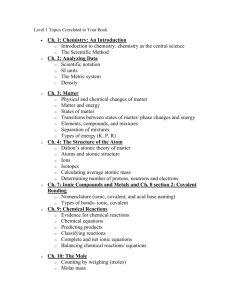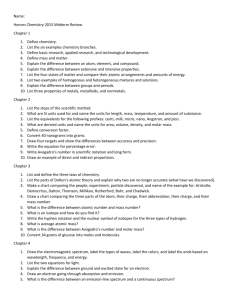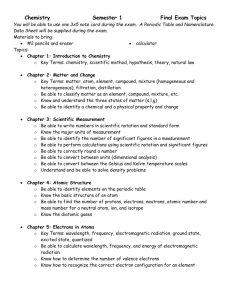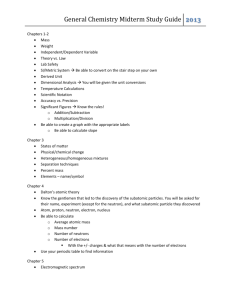Course Syllabus
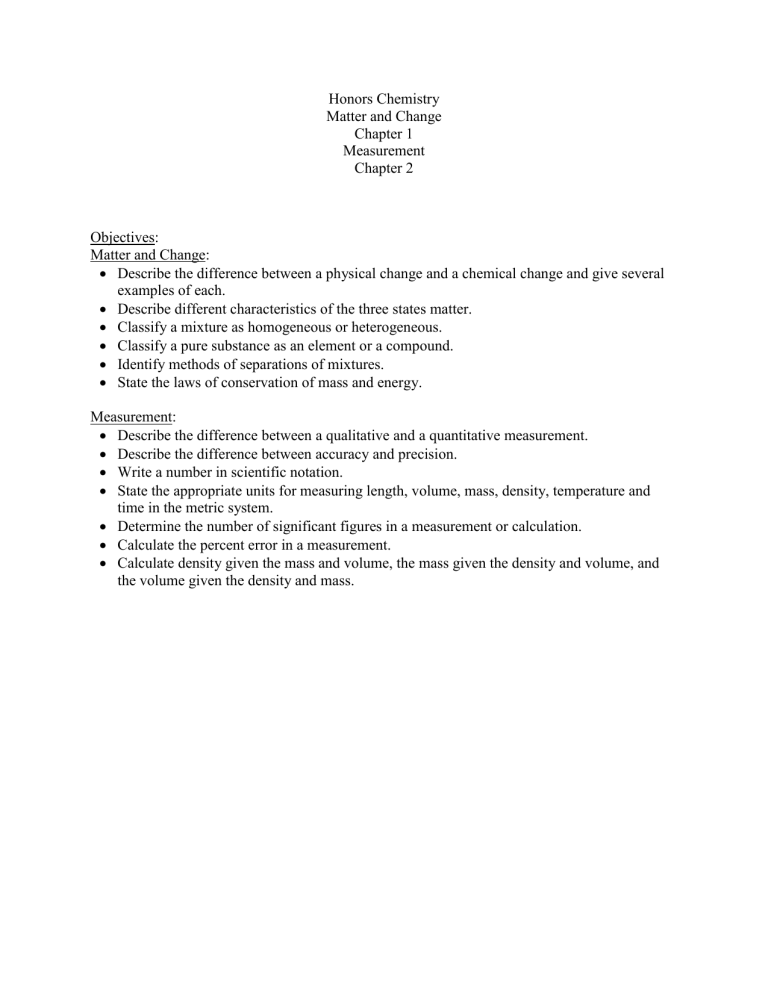
Honors Chemistry
Matter and Change
Chapter 1
Measurement
Chapter 2
Objectives:
Matter and Change:
Describe the difference between a physical change and a chemical change and give several examples of each.
Describe different characteristics of the three states matter.
Classify a mixture as homogeneous or heterogeneous.
Classify a pure substance as an element or a compound.
Identify methods of separations of mixtures.
State the laws of conservation of mass and energy.
Measurement:
Describe the difference between a qualitative and a quantitative measurement.
Describe the difference between accuracy and precision.
Write a number in scientific notation.
State the appropriate units for measuring length, volume, mass, density, temperature and time in the metric system.
Determine the number of significant figures in a measurement or calculation.
Calculate the percent error in a measurement.
Calculate density given the mass and volume, the mass given the density and volume, and the volume given the density and mass.
Honors Chemistry
The Mole
Chapter 3, pages 65-67 and 81-85
Chapter 7, pages 221-233
Chapter 11, pages 335-337
Chapter 13, pages 412-415
Objectives:
State the postulates of Dalton’s atomic theory.
Define the terms atomic mass and molar mass.
Define the terms mole and Avogadro’s number.
Write the name for common elements, given the symbol, or the symbol, given the name.
Calculate the molar mass of an element or compound, given its formula.
Identify the seven diatomic elements.
Calculate the mass of an element or compound given the number of moles, or the number of moles of a given mass of an element or compound.
Calculate the number of atoms or molecules of an element or compound given the number of moles, or the number of moles given the number of atoms or molecules.
Calculate the volume of a gas at STP (standard temperature and pressure), or the number of moles of a given volume of an element or compound.
Calculate the volume of a solid or liquid, or the number of moles of a given volume of an element or compound.
Define a solution’s concentration in terms of molarity.
Calculate the concentration of a solution, given the mass of solute and volume of solution, or the mass of solute needed to prepare a solution of a given concentration.
Calculate the percent composition of each element in a molecular formula.
Calculate the volume of water required to dilute a solution to a given concentration, or the concentration of a solution after a given amount of water is added.
Determine the empirical formula of a substance, given its elemental analysis.
Determine the molecular formula of a substance, given it empirical formula and molar mass.
Calculate the percent water in a hydrate, given its formula.
Determine the formula of a hydrate, given its percent water.
Honors Chemistry
Atomic Structure
Chapter 3 http://en.wikipedia.org/wiki/JJ_Thomson http://en.wikipedia.org/wiki/Oil-drop_experiment http://en.wikipedia.org/wiki/Geiger-Marsden_experiment
Radioactivity
Chapter 22
Objectives:
Describe the experiments of Thomson, Millikan, Rutherford and Chadwick and explain how they contributed to our present understanding of atomic structure.
Describe the mass and charge differences among electrons, protons and neutrons.
Define atomic number, mass number and isotopes in terms of the number of electrons, protons and neutrons.
Determine the atomic mass of an element from the percent abundance of its isotopes, or the abundance from its atomic mass.
Identify the optimum neutron-proton ratios from the elements’ atomic mass.
Identify the products of the most common nuclear decay processes.
Calculate the rate of decay of a radioactive isotope, given its half-life, or its half-life, given its rate of decay.
Calculate the mass defect and binding energy of a nuclide.
Describe nuclear fission and fusion, and calculate the energy released in terms of the mass defect.
Honors Chemistry
The Electron
Periodic Table
Chapter 4 (Skip Quantum Numbers)
Chapter 5
Objectives:
State the mathematical relationship between frequency (or wavelength) of light and its energy.
Describe the photoelectric effect and Einstein’s explanation of it.
Describe the observed emission spectra of atoms in terms of the particle nature of light.
Describe the Bohr model of the atom.
List the atomic orbitals of an atom.
Define the Aufbau Rule for filling atomic orbitals.
Define the Pauli Exclusion Principle.
Define Hund’s Rule.
Write the electron configuration for any element.
State the significance of an atom or ion possessing the noble gas configuration.
Correlate the electron configuration for an element with its position on the periodic table.
Describe the accomplishments of Dobereiner and Newlands in the identification of patterns of properties among the elements.
Describe the periodic tables of Meyer and Mendeleev.
Identify the various families of elements and define them based on the ions that they form.
State the trends in atomic radius, ionization energy, electron affinity and ion size within a group or period on the periodic table.
Identify the relationship between these trends and the structure of the atom (nuclear charge, filled energy level).
Honors Chemistry
Ionic Bonding
Chapter 6, Sections 1, 3
Metal Bonding
Chapter 6, Section 4
Covalent Bonding
Chapter 6, Sections 2, 5 (Skip Hybridization)
Nomenclature
Chapter 7, Section 1 (Skip Acids)
Objectives:
Ionic/Metal Bonding:
Write the electron configuration of ions of representative elements.
Define ionic bonds in terms of the difference in electronegativity of the atoms.
Write the Lewis electron dot structures of atoms, ions and ionic compounds.
Write the name of an ionic compound (binary, polyatomic and transition metal) given its formula, or its formula given its name.
Describe the properties of ionic, metallic, network covalent and molecular crystals and identify the forces holding them together.
Covalent Bonding:
Describe a covalent bond in terms of the difference in electronegativity of the atoms and the energy changes in bond formation.
Correlate bond energy and bond length for single, double and triple bonds.
State the octet rule and families of elements involved in exceptions to it.
Write the Lewis electron dot structures of compounds and ions containing covalent single, double and triple bonds.
Explain resonance and apply it to determine the bond orders of relevant compounds.
Describe the shapes of molecules using Valence Shell Electron Pair Repulsion (VSEPR)
Theory.
Identify appropriate molecular shapes (linear, trigonal planar, tetrahedral, pyramidal and angular/bent) and specify the corresponding bond angles.
Describe the effect of unshared electron pairs on bond angles.
Describe the formation of σ (sigma) and π (pi) bonds and identify them in molecules.
List the types of intermolecular forces and rank them by strength.
Determine whether a bond is polar or non-polar.
Determine whether a molecule is polar or non-polar.
Write the name of a binary covalent compound given its formula, or its formula given its name.
Honors Chemistry
Chemical Reactions
Chapter 8, Skip Balancing Equations
Chapter 14, Pages 425-430
Objectives:
Identify a reaction as a combination/synthesis, decomposition, single-replacement, double-replacement, or combustion reaction.
Predict the products of a chemical reaction.
Use the activity series of metals to determine which reactions are product-favored.
Predict the formation of a precipitate in an aqueous reaction, by applying the solubility rules for ionic compounds.
Decide whether or not a reaction is a redox reaction.
Write the half reactions for a redox reaction.
Write the net ionic reaction for aqueous reactions.
Honors Chemistry
Stoichiometry
Chapter 8, Balancing Equations
Chapter 9
Objectives:
Balance a chemical reaction.
Using the balanced chemical equation, determine the number of moles of reactant needed or product formed, given the number of moles of another reactant or product.
Calculate the theoretical mass yield of a reaction, given the balanced equation and reagent masses, reagent volume, or volume of solutions of known concentration.
Calculate the theoretical volume yield of a reaction (if a gas, at STP), given the balanced equation and reagent masses.
Calculate the concentration of solution of a product of a reaction, given the balanced equation and reagent masses.
Identify the limiting reagent in a chemical reaction and the maximum amount of product that can be formed, given the amount of each reagent.
Calculate the percent yield in a chemical reaction, given the amount of product formed.
Calculate the percent composition of an impure mixture.
Honors Chemistry
Gases
Chapter 10
Chapter 11 (Sections 1-2)
Objectives:
Explain the relationship between the temperature of a sample of gas and the kinetic energy of the particles of that gas.
Describe how pressure is measured with a barometer and manometer.
Convert values of pressure among the common units.
Determine the relationship between pressure and volume of a gas (Boyle’s Law).
Determine the relationship between temperature and volume of a gas (Charles’ Law).
Determine the relationship between temperature and pressure of a gas (Gay-Lussac’s Law).
State Avogadro’s hypothesis relating particles of a gas to volume.
State Dalton’s Law of partial pressure and its relationship to Avogadro’s hypothesis.
Describe an ideal gas.
Calculate the amount of gas at any specified conditions of pressure, volume and temperature.
Determine the molar mass of a gas from its density.
Honors Chemistry
Solutions
Chap. 13, Pages 401-410, 416-418
Chap. 14, Pages 436-444
Solutions:
Calculate the molality of a solution.
Calculate the mole fraction of a solution component.
Describe the relationship of temperature and vapor pressure of a pure liquid.
Define the boiling point of a pure liquid.
State the mathematical relationship between the vapor pressure of a solution and its concentration (Raoult’s Law).
State the mathematical relationship between solubility and pressure of a gas (Henry’s Law).
Describe a solvation as exothermic or endothermic based on the change in maximum solubility as a function of temperature.
State the mathematical relationship on the dependence of freezing point or boiling point on the concentration of the solution.
Calculate the freezing/boiling point of a solution given the solution concentration, or the concentration given the freezing/boiling point.
Calculate the molar mass of a solute from its freezing point depression/boiling point elevation.
Calculate the osmotic pressure of a solution.
Predict the flow of solvent when two different solutions are in contact with a semipermeable membrane.
Honors Chemistry
Electron Transfer
Chapter 19.3-19.4
Objectives:
Describe the components of a galvanic/voltaic cell.
Define the chemical reactions occurring at the cathode and anode of an electrochemical cell.
Calculate E° for an oxidation-reduction reaction.
Describe the difference between a galvanic cell and an electrolytic cell.
Define batteries, fuel cells and corrosion in terms of electrochemical reactions.
Honors Chemistry
Acids and Bases
Chapters 15 and 16
Objectives:
Acids/Bases:
Describe the physical properties of acids and bases.
Define acids and bases in terms of the ionization of water. o Arrhenius o Bronsted-Lowry o Lewis
Write the chemical formula for an acid given the name, or the name given the formula.
Determine the products of a reaction of an acid and a base.
Identify the conjugate acid-base pairs of a reaction.
Define pH and pOH in terms of the ionization of water.
Calculate the pH of a solution of a strong acid or base.
Describe the difference between strong and weak acids and bases.
Define the terms polyprotic and amphiprotic/amphoteric.
Determine whether an oxide is acidic or basic.
Calculate the concentration of an acid or base by titration.
Describe how an indicator performs in a titration.
